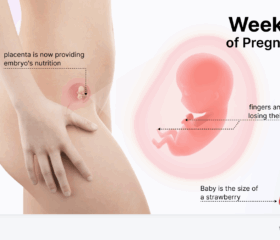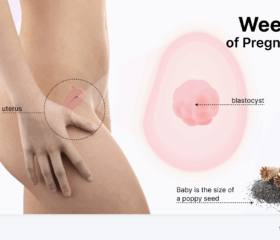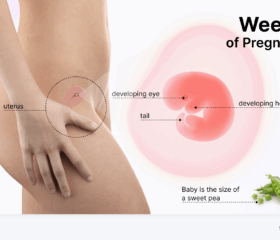Pregnancy Week by Week
42 Weeks Pregnant
Your baby is as big as a large pumpkin.
20.5
inches
8.12
pounds
42 Weeks Pregnant: What to Do When You’re Overdue
Even though your due date is almost certainly behind you, you’re not alone; a certain percentage of pregnancies continue past the 40-week mark of pregnancy. Here’s what you can expect at 42 weeks pregnant.
Is it a problem being pregnant at 42 weeks?
In most cases, no. Your estimated due date is just that—an estimate. Less than 5% of babies are born on their exact due dates. 1
Often, a “post” or “late-term” pregnancy isn’t actually post-term but is a result of a miscalculation of conception due to irregular ovulation or uncertainty about your last menstrual period when you were discussing with your doctor or using a due date calculator. 2
Even if you are truly overdue, you’ll go into labor—either naturally or through induction—before this week is over. As for your little one, most babies thrive well past 40 weeks.
Still, your doctor will keep a close eye on you and your little slowpoke this week to ensure everything goes well.
What are the dangers of going past your due date?
Even though most post-term pregnancies result in healthy deliveries, there are a few concerns to be aware of: 2
- Placental problems: The placenta might not function as effectively past your due date, which can affect your baby’s oxygen and nutrient supply.
- Low amniotic fluid: Your baby’s amniotic fluid (the liquid she’s suspended in) might run low, which can cause complications.
- Umbilical cord compression: Your baby’s umbilical cord might be compressed, which can impact her blood flow.
- Meconium aspiration: If your baby passes meconium (her first poop) in the womb, there’s a risk of her inhaling it during birth.
- Macrosomia: Your baby may become very large, which can increase the chances of you needing a C-section.
Try not to let these potential complications scare you (although you shouldn’t dismiss them, either—it’s good to take them seriously). Just stay in regular contact with your doctor, who will monitor you and your baby and let you know if there are any concerns.
Your baby at 42 weeks
Your baby is now about the size of a large pumpkin, measuring around 20 inches long and weighing about 8 pounds. 3 At this point, all of her organs and systems are fully developed and ready for life outside the womb.
You might notice she looks a little different from other babies when she’s born. Babies born later might: 4
- Have dry, cracked, or peeling skin
- Have longer fingernails and more baby hair
- Be more alert and wide-eyed
All of this is just the result of staying in the womb a little longer than normal. Once she’s born, your baby will continue developing normally.

Your body at 42 weeks
At 42 weeks, you might feel like you’ve been pregnant forever. As far as your symptoms go, here’s what you might encounter:
- Increased Braxton Hicks contractions: These Braxton Hicks or “practice” contractions might get more frequent as your body prepares for labor. If your contractions become regular, lasting at least 45 seconds, and occur more often than every 5 minutes, it’s time to contact your doctor.
- Cervical dilation or effacement: You may have started dilating by now. Your doctor may track the dilation and thinning of your cervix as labor approaches. 5
- Diarrhea: Many women suffer from diarrhea as they get closer to labor. 6 Make sure you drink enough water to make up for the fluids you lose.
- Edema: As your body retains more fluid, you might find that swelling in your feet and ankles gets more pronounced. 7
- Pregnancy insomnia: If you’re feeling uncomfortable, anxious, or you just need to pee more often, you may struggle to get a good night’s sleep.
- Leaky breasts: If you haven’t already, you may have colostrum leaking from your breasts. This thin, yellowish fluid will be your baby’s first meal. Try using nursing pads to combat leaks.
How to recognize when labor is approaching
Any minute now, your baby could decide she’s ready for the outside world, so make sure you know the signs that labor is imminent. Here’s what to look out for:
Bloody show
Don’t let the name fool you—this isn’t as bad as it sounds. As your cervix begins to dilate, you might notice your vaginal discharge is tinged with pink or brown.
This is normal and indicates that labor isn’t far away. However, you should report heavy, bright red bleeding to your doctor, as it could indicate a more serious issue. 8
Water breaking
When the amniotic sac (the bag of fluid encasing your baby) ruptures, fluid will start gushing or leaking out of your vagina. This is commonly known as your water breaking.
Unlike your regular vaginal discharge during pregnancy, amniotic fluid is typically odorless and either clear or pale yellow. Usually, contractions start within 24 hours of your water breaking. 8
If you notice tinges of green or brown in the amniotic fluid, report it to your doctor. This might mean that your baby has passed meconium, which could indicate that she’s distressed. 9
Regular contractions
You’re probably familiar with one of the more infamous signs of labor—regular contractions that feel very painful.
It’s easy to mistake Braxton Hicks contractions for true labor contractions. However, there are differences between the two. Check out the table below to help distinguish your contractions: 10
Differences between true labor contractions and Braxton Hicks contractions
| Characteristic | True labor contractions | Braxton Hicks contractions |
|---|---|---|
| Pain | - Very painful - Get more intense over time |
- Not usually painful |
| Frequency | - Regular (intervals of 10 minutes or less) - Don’t subside no matter what you do |
- Irregular - Usually subside when you change positions, drink fluids, or take a walk |
| Length | - Usually last 30–70 seconds | - Usually last 15–30 seconds (though sometimes up to 2 minutes) |
| Other signs of labor | - Are accompanied by other signs of labor | - Aren’t accompanied by other signs of labor |
What will happen when you see your doctor this week
You and your baby will receive extra monitoring this week. This may include:
- Non-stress tests (NST): These tests monitor your baby’s heart rate and responsiveness. 11
- Biophysical profile (BPP): This ultrasound assesses your baby’s breathing, movement, muscle tone, and her levels of amniotic fluid. 12
- Regular check-ups: Your doctor will also check for signs of preeclampsia or other conditions that could affect your health.
Induction of labor
If you haven’t gone into labor naturally, your doctor may recommend inducing labor, especially at 42 weeks. Here are some common methods of labor induction: 13
- Stripping the membranes: Your doctor will use a finger to separate the amniotic sac from your uterine wall, which can release the hormones that trigger contractions.
- Breaking your water: Your doctor will perform an amniotomy, which involves using a special tool to rupture the amniotic sac. This procedure often leads to the start of labor within hours.
- Cervical ripening: Your doctor will insert synthetic prostaglandins (lipid metabolites that can trigger biological functions) vaginally (or you may take them orally) to soften and dilate your cervix. 14
- Foley bulb or balloon: Your doctor will insert a catheter with a balloon at the end into your uterus, and then gently inflate it to encourage your cervix to open. Labor normally starts within 12 to 24 hours of the procedure.
- Injecting oxytocin: Your doctor will administer a synthetic version of oxytocin (Pitocin) through an IV to start contractions.
Ultimately, it’s up to you which option you want. Chat with your doctor about which is right for you.
How to care for yourself and your baby this week
Let’s face it; sitting around waiting for your baby to make her debut can leave you feeling anxious. While you wait for the big day, here’s how you can stay positive and prepare:
- Relax and manage stress: If you feel anxious that your baby hasn’t arrived yet, try to relax. Consider exploring the benefits of prenatal yoga, meditation, or prenatal massage—all of which are great ways to ease your mind.
- Continue kick counts: You should have started doing kick counts in week 28 of your pregnancy. Keep monitoring your baby’s movements and report any changes to your doctor. You want to feel at least 10 kicks within 2 hours. If you don’t, call your doctor right away. 15
- Treat yourself: Indulge in the activities you enjoy the most, whether that means a nap, a treat, or buying some new clothes for when that baby belly disappears.
How to prepare for the postpartum period
The challenges won’t stop as soon as your baby’s born. Here’s how you can prepare for your postpartum recovery:
- Gather the essentials: Get some peri pads, a peri bottle, numbing spray, ibuprofen, extra undies, and ice packs to alleviate any discomforts down the line.
- Consider a postpartum doula: A doula can help care for you and your baby, including offering breastfeeding advice, cooking, childcare, and light cleaning.
- Be prepared for longer hospital stays: After a vaginal birth, expect around two nights in the hospital. After a C-section without complications, it’ll usually be 2–4 nights. 16 If you or your baby experience any complications, you may have to stay even longer.
It’s no secret that the postpartum period can be tricky to navigate. Since you’ll have a wide-eyed, hungry, and oftentimes fussy baby in tow, it’s easy to let your own needs fall by the wayside.
You don’t have to deal with it alone. Let your family and friends know how you’re feeling and your plans for labor, delivery, and the following weeks so they can give you the support you need.
You can also consider downloading a baby tracker app to help you manage you and your baby’s new life and schedules together.
Final thoughts
While you may be more than ready to be done with your pregnancy, don’t let it get you down. Whether labor begins naturally or through induction, this week, you’ll finally meet your baby.
Try to enjoy your last few days of peace and quiet before you’re busy changing diapers. Your doctor or midwife will be on call when you need them. Brace yourself for the big day!
Article Sources
- University Hospitals Sussex NHS Foundation Trust. "Preparing for the birth" Retrieved July 1, 2025.
- Stanford Medicine Children’s Health. "Post-Term Pregnancy" Retrieved July 1, 2025.
- Baby Your Baby. "Fetal Growth Chart" Retrieved July 1, 2025.
- The Children's Hospital of Philadelphia. "Postmaturity" Retrieved July 1, 2025.
- Eunice Kennedy Shriver National Institute of Child Health and Human Development. "What are the stages of labor?" Retrieved July 1, 2025.
- American Pregnancy Association. "Diarrhea During Pregnancy" Retrieved July 1, 2025.
- National Health Service. "Swollen ankles, feet and fingers in pregnancy" Retrieved July 1, 2025.
- MedlinePlus. "Am I in labor?" Retrieved July 1, 2025.
- American Journal of Obstetrics & Gynecology. "Meconium-stained amniotic fluid" Retrieved July 1, 2025.
- UNM Health Sciences Center. "Common Discomforts During Pregnancy" Retrieved July 1, 2025.
- MedlinePlus. "Nonstress Test" Retrieved July 1, 2025.
- Stanford Medicine Children’s Health. "Biophysical Profile" Retrieved July 1, 2025.
- MedlinePlus. "Inducing labor" Retrieved July 1, 2025.
- Encyclopedic Reference of Immunotoxicology. "Prostaglandins" Retrieved July 1, 2025.
- Florida Health. "Paper Kick Chart" Retrieved July 1, 2025.
- Mount Sinai. "Going home after a C-section" Retrieved July 1, 2025.







